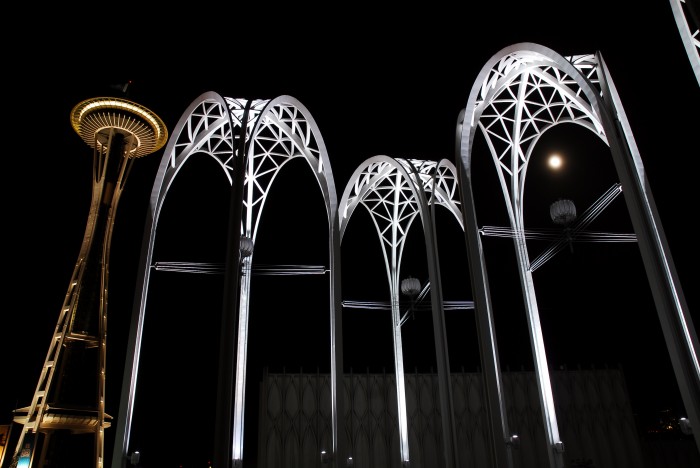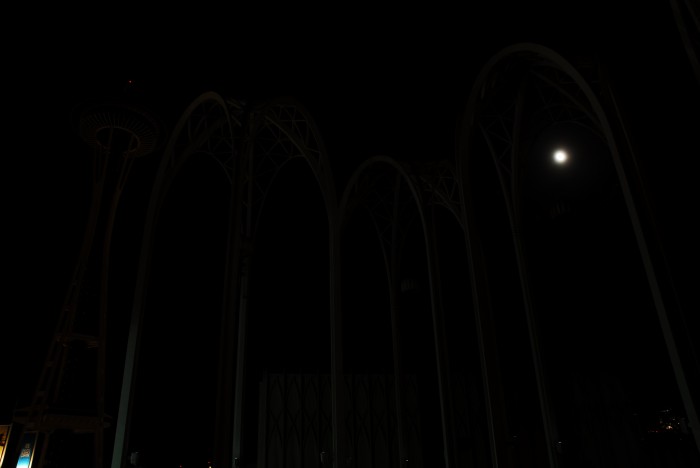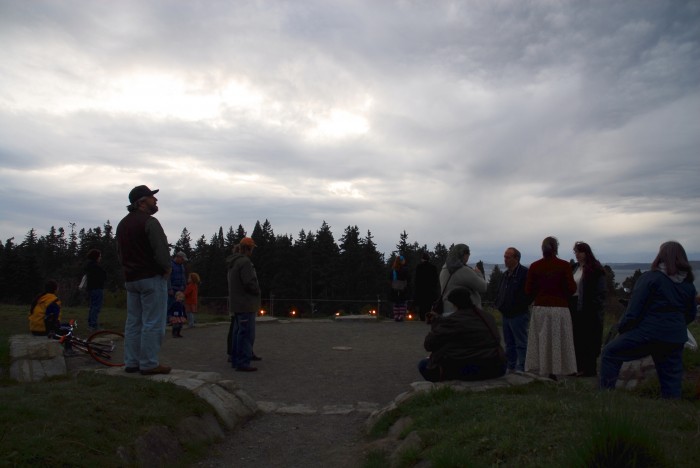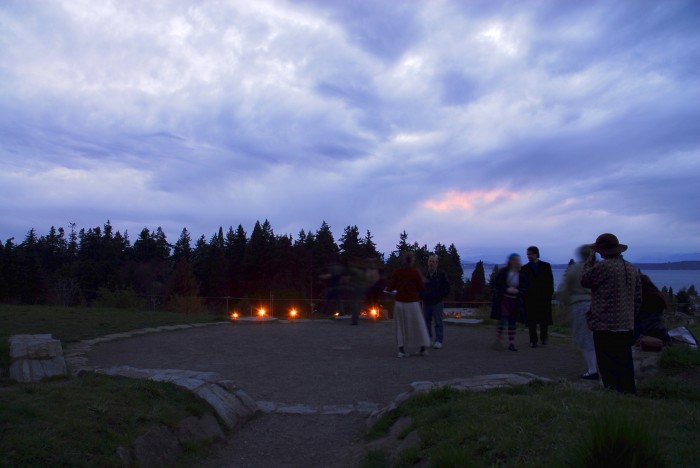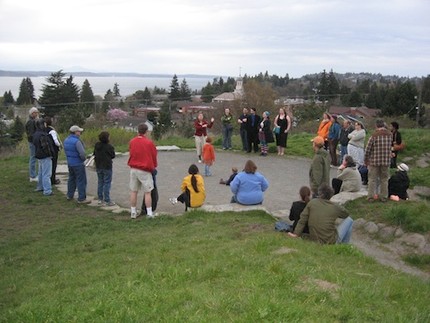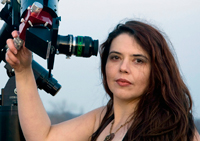Archive for 2010
 Iceland Volcano – Eyjafjöll (April 14, 2010)
Iceland Volcano – Eyjafjöll (April 14, 2010)
The Eruptions
Eyjafjallajökull has been active in the last few days. Dr. Erik Klemetti of Eruptions blog has a great write up. Go listen to him. Also, Jorge Santos has the best picture of the ash.
Most recently, on 4/14/2010 (or 14-4-2010 if you’re not in the US):
After a few days of quiet in Eyjafjallajökull volcano, a new and much more forceful eruption has begun west of Fimmvörðuháls, under the ice-cap.
The eruption is below the highest peak of Eyjafjallajökull, at the southern rim of the caldera.
A plume rises at least 8 km into the air. No lava is seen yet but melt-water flows both north and south of the mountain.
-Iceland Meteorologic Office
At 2300 on 13 April, a seismic swarm was detected below the central part of Eyjafjöll, W of the previous eruption fissures. About an hour later, the onset of seismic tremor heralded an eruption from a new vent on the S rim of the central caldera, capped by Eyjafjallajökull glacier. The eruption was visually confirmed early in the morning on 14 April; an eruption plume rose at least 8 km above the glacier. Meltwater flowed to the N and S. News outlets reported that a circular ice-free area about 200 m in diameter was seen near the summit. Scientists conducting an overflight saw a new 2-km-long, N-S-trending fissure, and ashfall to the E. About 700 people were ordered to evacuate the area, and certain flights were banned from flying N and E of the eruption area. Flooding increased throughout the day, causing road closures and some structural damage.
-Institute of Earth Sciences
The Volcano
Eyjafjöll is also known as Eyjafjallajökull. It’s a strato volcano – so more of a pointy volcano (like Mount Vesuvius), less of a flat volcano (like Hawai’i). Eruptions from strato volcanoes are often more powerful and spread more ash and less lava. Near Seattle the Cascades have many strato volcanoes: Mount Rainier, Mount Saint Helens, Crater Lake, Shasta, etc.
Good places for more information?
The volcano itself (from the Global Volcanism Program).
The eruption on 4/14/2010 (from the Iceland Meteorological Service)
News from the Iceland Meteorological Service
USGS Worldwide Volcanic Activity Report
NASA’s Earth Observatory Photographs from Space
![]()
~ A l i c e !
 Science with a Twist, Astronomy Day, and Carnival of Space
Science with a Twist, Astronomy Day, and Carnival of Space
First off Astronaut Greg Johnson will be at this week’s Science with a Twist on Thursday April 15th at Pacific Science Center. The event is also on Facebook. I’ll be there too, holding a brief discussion about false color, and Toni Meyers, director of Hubble 3D will be speaking about the film.
“Science with a Twist will celebrate Hubble 3D. Toni and Greg will circulate during the event and introduce the film and answer questions after the film. Pacific Science Center’s resident NASA Solar System Ambassador, Alice Enevoldsen, will also lead you through an explanation of astronomical images: What do you see vs. What’s really there? Tickets for staff are only $17 (21 +, ID required)”
Toni Myers is the director and producer of Hubble 3D and one of the few women directors in the history of IMAX filmmaking. Toni has worked on IMAX documentaries since 1971. She has worked on every IMAX space film and has worked directly with over 120 astronauts and cosmonauts in the making of the IMAX space films. She has an extensive background in a variety of films in addition to IMAX filmmaking . In addition to documentary projects she has a background in the music world having worked on music projects for the Beatles’ company, Apple; and individual features and videos for John Lennon and Yoko Ono. The IMAX documentaries that Toni has worked on have been among the most successful here at the Science Center including Under the Sea 3D. For her work on Hubble 3D the astronauts of the STS-125 crew presented her with the Silver Snoopy Award in recognition of her excellence and
achievements in bringing the space experience to IMAX audiences around the world.
Greg Johnson graduated from West Seattle High School and from the UW with a degree in aerospace engineering. He received his Naval Aviator wings in December 1978. He served as a senior research officer in Office of Naval Research. He has logged over 9500 flying hours in 50 aircraft and has over 500 carrier landings. In 1990, he was accepted as an aerospace engineer and research pilot at NASA . He joined the astronaut program in 1998. He was the pilot the final Space Shuttle mission to the Hubble Space Telescope. On this mission he logged almost 13-days in space—–traveling 5,276,000 miles in 197 Earth orbits at 17,500 miles per hour. And he was an IMAX cinematographer on the mission.
Next, April 24th will be Astronomy Day at Pacific Science Center. Here’s a copy of that e-mail:
Calling all astronomy enthusiasts!
Celebrate the 20th anniversary of the launch of the Hubble Space Telescope at Pacific Science Center on April 24th.
What: Pacific Science Center presents Astronomy Day
When: Saturday, April 24th 10am-6pm
Where: Pacific Science Center
Astronomy Day this year will be in style at Pacific Science Center! With planetarium shows, hands-on exhibits in Facing Mars, facilitated space-themed activities with our onsite Science Interpretation staff, crafts, and the eagerly-anticipated IMAX film Hubble 3D this day of science just won’t end.
IMAX FILMS
Hubble 3D
Showing April 24th at 10:30am & 11:45am
The perfect way to celebrate the 20th Anniversary of the launch of the Hubble Space Telescope is to take in a screening of this new IMAX film which is gaining rave reviews! Today’s Seattle Times review calls Hubble 3D an “extraordinary spectacle” and an “out of this world documentary.” http://seattletimes.nwsource.com/html/movies/2011381515_mr19hubble.html
Roving Mars
Showing April 24th at 11:30am, 1:30pm, 3:30pm and 5:30pm
Go behind the scenes with NASA scientists and engineers as they worked to design Mars Rovers, Spirit and Opportunity, to travel millions of miles to Mars and report back!
FEATURED EXHIBIT
Facing Mars
Open 10am-6pm
Here’s your chance to experience the sensations, emotions and conditions of a real trip to Mars without ever leaving Earth! Build your own simple rocket, take a “Mars Walk,” see firsthand what microgravity does to the human body and so much more!
Last, you should go look at Carnival of Space #149!
Okay, enough advertising. I’ll tell you more science-y stuff next week.
![]()
~ A l i c e !
 Earthquakes and the Length of a Day
Earthquakes and the Length of a Day
The fabulous and illustrious duo Beth and James requested that I educate you all further on the relationship between the Chilean Quake and the rotation of the Earth. A worthy topic.
In Short
The big earthquake in Chile shifted enough of the mass of the Earth far enough that (like a figure skater bringing her arms in toward his body) the Earth actually sped up slightly – shortening our day by 1.26 microseconds. Maybe – the number will be refined further.
Quote
JPL research scientist Richard Gross computed how Earth’s rotation should have changed as a result of the Feb. 27 quake. Using a complex model, he and fellow scientists came up with a preliminary calculation that the quake should have shortened the length of an Earth day by about 1.26 microseconds (a microsecond is one millionth of a second).
Perhaps more impressive is how much the quake shifted Earth’s axis. Gross calculates the quake should have moved Earth’s figure axis (the axis about which Earth’s mass is balanced) by 2.7 milliarcseconds (about 8 centimeters, or 3 inches). Earth’s figure axis is not the same as its north-south axis; they are offset by about 10 meters (about 33 feet).
-JPL Media
In Detail
Overwhelmed? I’ve highlighted the pieces you should pull out of that.
Conservation of Angular Momentum
You cannot create energy or matter out of nothing. These laws are called “conservation of matter” and “conservation of energy.” We’ve got one for spin (angular momentum) too. If you’re spinning you either keep spinning (at the same speed) or you pass off some of that momentum to another object. This causes the oft-referenced effect of the figure skater’s pirouette. She begins to spin with her arms out, gets up some speed, and then pulls her arms and legs in tight. She spins significantly faster in this configuration. Later she puts her arms out again and slows down.
You can do this at home. Grab two cans of food and a spinning office chair. If you do not also find yourself at least fifteen by fifteen feet square of clear space, I take not responsibility for your bruised knuckles (you WILL knock into something if you don’t have plenty of room around, so don’t hurt yourself). Get a friend to start you spinning, with the cans held at arms length in your hands. As soon as you’re going, pull the cans in to your body. Try it the other way – starting with your arms in too.
This is conservation of angular momentum.
Figure Axis
Why were we talking about that? Because of the figure axis. You know the Earth is round, and you also know the Earth is not a perfect sphere because of that hill you had to bike up to get to work today. The Earth rotates on its axis, once a day, and that axis is pointed at the North star.
Now, imagine your washing machine – it spins too. Where is that axis? Yup, right down the middle. The figure axis is different though – it’s the axis around which the mass is all balanced. In a normal situation for your washing machine, these two axes are about the same. Now imagine it gets off balance – all your clothes end up on one side of the drum.
First, where is the spin axis? Yes! Same exact place – right down the middle (sorta, you hope). The mass (your soggy clothes) have changed places though, and they’re all on one side. Imagine a line that intersects the middle of the clothes pile. It’s off to one side, and in fact, as the washing machine spins, the figure axis is rotating around the spin axis with the clothes.
Re-balance your load of laundry so it doesn’t make your washing machine walk and let’s talk about the Earth.
The Earth’s figure axis (balance of mass) is very close to its spin axis, but they aren’t the same. If you move one of the Earth’s plates a lot – it’s like moving the towel in the laundry around, you’re messing with the balance of the mass. In the case of the Chilean earthquake we have one plate subducting under another, which means some mass moving closer to the center of the Earth. It’s not moving far, it’s not getting that much closer to the Earth, but if you’re doing minute calculations it is definitely enough to have that conservation of angular momentum effect (spin a little faster as mass moves in) due to the shifting of the mass of the Earth.
Calendar Change
A student came up and asked today if that meant the atomic clocks needed to change. Well, no, but the atomic clocks are pretty much just counting time passing anyway, in oscillations specific atoms. The question you want to ask is, are the “atomic calendars” going to change?
First off, I must point out I don’t know if there are calendars kept to the level of accuracy that is implied in the term “atomic calendar.” Perhaps these folks?
Second, no, not yet. Richard Gross’s calculations are preliminary. Once they are solidified, the next leap second will take care of it. Does that mean a leap second isn’t actually exactly a second?
Want More?
Microseconds – a measure of time
Milliarcseconds – a measure of angle (like a degree is a measure of angle)
International Earth Rotation and Reference Systems Service
I’m embarrassed to say, but I got the idea for the washing machine analogy off Yahoo Answers. I was just going to use the figure skater till I read the concept there. I’m also going to have to talk about the ways the Earth moves sometime.
![]()
~ A l i c e !
 Carnival of Space #147
Carnival of Space #147
Check out Carnival of Space #147 hosted by Weird Sciences. Phil’s got a great post linked.
![]()
~ A l i c e !
 Earth-Centered Events
Earth-Centered Events
Today is “just” some photos for you of the Earth-Centered events that have happened over the last week. First, Earth Hour just finished here in Seattle – so a pretty before-and-after of Pacific Science Center and the Space Needle. (Click to get the full-resolution versions).
Equinox Sunset
I haven’t had a chance to tell you how fun the West Seattle 2010 Spring Equinox Sunset Viewing at Solstice Park was. Unfortunately, we didn’t see the Sun … remember, this is Seattle. If you schedule a sun-dependent event, it will be cloudy. Anyway, we had 30-40 folks show up, and had a good time anyway. Greg posted a nice piece over at the Seattle Astronomy Examiner about it. (Click pictures to see high-res)
![]()
~ A l i c e !
 Ada Lovelace Day Featuring: Pamela Gay
Ada Lovelace Day Featuring: Pamela Gay
Good morning! Welcome to Ada Lovelace Day, a day where we celebrate women in technology (etc) through blogging.
I’d like to introduce you to a friend of mine, Dr. Pamela Gay, research astronomer, podcaster, gateway to science for the average Mr. or Ms. Doe, Skye-rider (that’s her horse), and internet-addict. Oh, and P.S. – you didn’t hear it from me but she has two X chromosomes. That’s right, she’s female.
Pamela Online
Although she does many things (in her own words, “Some days I suspect I wear too many hats. Other days, I know I wear too many hats!”) and I’ve heard tell she has a penchant for variable stars, Pamela’s research at the moment is focused online, and on how it is that internet users interact with astronomy content. She certainly has plenty of fodder for this research: her online projects include writing, voicing, and producing Astronomy Cast; masterminding 365 Days of Astronomy (you’ve heard me on there once, and you’ll hear me again in May); and being part of the Zooniverse team – a citizen science astronomy project. Oh, and of course she has a blog: StarStryder.
A la Twitter, I asked her to describe herself in 140 characters or less. I’m not sure I could do it, but she did:
I am a female scientist focused on communicating the majesty of the universe & the realities and struggles of academia one day at a time.
Teaching and Learning
No matter how much you enjoy your job, there are going to be at least a few days where you’d rather not get out of bed. A few tasks you just don’t want to face. On those days you focus on the part you love. For Pamela it’s easy to identify: “seeing students realize they can be more then they ever imagined and can do more with their lives than they ever dreamed,” she says. I have to agree. Watching a moment of understanding, seeing students achieve something they’ve fought for – that’s the reward for teachers.
It’s also why I admire Pamela’s work. Not only does she have the Ph.D. in Astrophysics, but she pushes back against the idea that this means she has to sit holed up in an office cranking through numbers and churning out papers. She teaches in as many ways as she can, even when colleagues choose not to treat that output as valuable (a judgment both teachers and women have to face fairly often).
Thing is, it’s people like Pamela who will influence the next crop of astrophysics researchers. It is people like Pamela who will convince students that they can become the next Nobel Laureate or the next Carl Sagan or the next professor of Astronomy. And she’s not “just a teacher,” she’s published – over and over and over again. She’s documented her influence scientifically.
Only Human
Sometimes it seems like the women we look up to have superpowers. Guess what? Einstein and Annie Jump Cannon were human, and so is Pamela. She might have caffeine running through her veins rather than blood, but she makes time in her life for her husband, horseback riding (did you hear that girls near the age of seven? You can be an astrophysicist and also continue to love horses!), gardening, and renovating her house.
So, listen to her next podcast and enjoy it, whether you decide to go into astronomy research or not. If you do decide to head in that direction though, “open doors for yourself by playing with technology,” says Pamela. You’ll be able to use the experience. Take some programming classes, some math classes, and definitely learn to write – if you can communicate your ideas you’ll be able to show people why what you do is cool, and you’ll be able to convince folks to give you funding.
Want More?
Last year I blogged about Susan Sakimoto, and mentioned a lot of other people I admire and respect:
I always have trouble deciding who to write about. There’s Ada herself, of course, and Annie Jump Cannon, Cecelia Payne-Gaposhkin, and Williamina Fleming. And then there are the current scientists (most of whom you’ve never heard of because you tend not to get famous until you’re dead or almost dead): Hannah Jang-Condell, Susan Sakimoto, Andrea Dobson, Pamela (the list goes on and on and on). Not to mention my students or the faculty and grad students I’ve met at the University of Washington. Students are really important and really inspiring – except when they’re slacking off. You can see some women in science I’ve met (as interviewed by two high school interns last summer) over at the Scientists Like Me project – which will eventually become part of the We Are All Astronomers project (another Pamela special).
![]()
~ A l i c e !
 Carnival of Space & Link
Carnival of Space & Link
If you’re not currently subscribed to my new feed through feedburner you should be. It’s easy just click here, or click the orange box at the top of the page near the search bar, or input http://feeds.feedburner.com/AlicesAstroInfo into your favorite RSS feed reader.
Onward:
Carnival of Space #146 is live at Simioastronomy – check it out, lots of Hubble goodness.
Also, Seattle Astronomy Examiner Greg Schneiderer reports on my Equinox Sunset party from Saturday evening. He’s got photos in case you missed it.
![]()
~ A l i c e !
 Wednesday, March 17, 2010
Wednesday, March 17, 2010
Happy Saint Patrick’s Day!
We discussed how planets are detected. Gravitational detection (as for Pluto), astrometry – redshift/blueshift of a star as its planets pull on it, and transit detection. We talked about the Kepler mission. We watched 20 minutes of Armageddon and made fun of it, and we watched NASA’s Deep Impact mission crash into a real comet as well as some videos of astronauts falling down on the Moon.
 Monday, March 15, 2010
Monday, March 15, 2010
Beware the Ides of March!
We took a quiz on Jovian planets.
We talked about life in the Universe.
If you want, here’s a link to Neil DeGrasse Tyson’s NOVA Special “The Pluto Files“

